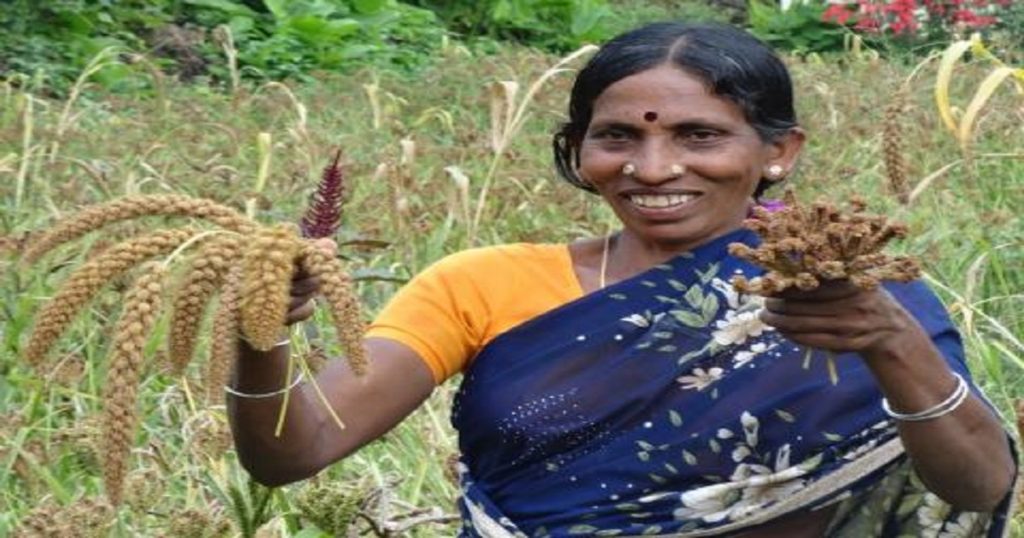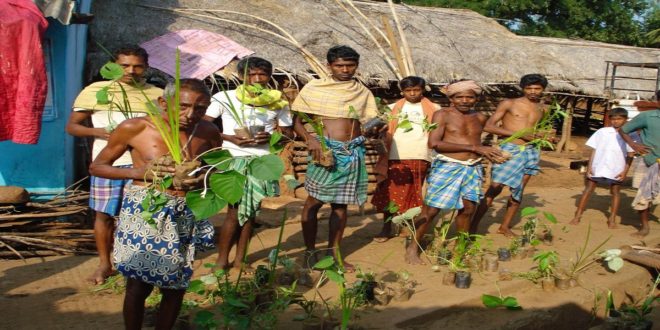Chennai : How do we translate present policies into effective practices, for local health, primary healthcare services and protect biodiversity heritage of India? Bringing all of these together here are a series of 10 recommendations that have been built with evidence from years of research.
A major reason for emergence of new viruses and diseases is destruction of forests and loss of biodiversity. Local Health Traditions (LHTs) and environmental health boost immunity and conservation of biodiversity. In the post-COVID era, we look back at age-old healthcare practices and homestead-level biodiversity conservation, based on evidence from research in conservation, cultivation, consumption and community-centric commerce of biodiversity in three bio-cultural diversity hotspots of India.
India is a core region of bio-cultural diversity in the world, which means symphony in the nature-culture relationship. Products used for human consumption from food to cosmetics, were done in harmony with nature over generations. MSSRF has been working in three ‘Bio-cultural diversity hotspots’ of India – the Wayanad region in Kerala, Koraput region in Odisha and Kolli Hills in Tamil Nadu – to revitalize non-codified Local Food and Healthy Traditions. Our green-health programme since 1998 to 2005 focused on (i) Rejuvenation of Local Health Traditions, (ii) inventory, collection, multiplication and documentation of medicinal plants; (iii) promotion of medicinal rice Navara; and (iv) survey and documentation of wild food plants; and (v) promotion of millet-based health foods.
- The rejuvenation of local health traditions aimed to promote sustainable use of medicinal and edible wild and little-known nutrition-rich plant diversity of India. Promoted through trained women Self-Help Groups and farmers’ forums under the traditional healers, ayurvedic physicians, botanists and nutrition experts resulted in revitalizing many primary health care traditions, household-level herbal collections and consumption of medicinal and wild edible plants, and establishment of herbal gardens in these three hotspots.
- As part of the inventory and documentation, Wayanad has an active collection of 300 species and Koraput, an active collection of 350 species. A nursery in these gardens raises all-important plants in primary healthcare to supply identified medicinal plants to households and form community-level medicinal plant gardens and commercial cultivation Over the past 10 years, one lakhs seedlings have been distributed to households of SHG members.
- Navara rice in cultivation in Kerala for over 2,500 years since Susruta, the Indian pioneer in medicine and surgery, is reported to have multiple uses nutritious, balanced and safe food for people of all ages. Rice paste to rejuvenate muscles, and body massage with roots of the medicinal plant Bala (Sidaalnifolia var. alnifolia) offer vitality and immunity. In local health care system Navara is also used in diarrhoea, urinary diseases, muscle wasting, burns and scalds. MSSRF’s detailed survey alongside farmers, helped strengthen informal research and become partners research where emphasis was on learning from farmers. Many of these properties were clinically evaluated to scientifically publish these benefits.
- Study of the extensive knowledge of tribal groups of Wayanad regarding wild food showed 372 wild edibles accessed by tribal communities, including 102 leafy greens, 19 species of Dioscorea, 40 species of wild mushrooms, 5 species of crabs, 39 species of fishes and five types of honey (Ratheesh Narayanan et al 2004, Anil kumar et al 2011) some serving as ‘life saving’ plant groups to marginal farming and forest communities, during food scarcity.
- Compared to rice the main staple food in India, millets have higher protein however with the need to be complemented with legumes to fulfil protein needs. Diets containing Kodomillet (Paspalumscrobiculatum) and finger millet (Eleusinecoracana) flour have potential benefits to mitigate or delay onset of diabetes-related complications. Finger millet is extremely high in calcium, highest among all cereals and can overcome calcium deficiency of a rice diet. Investigations to assess nutrition/health outcomes showed women’s adequate dietary level of calcium was directly linked to finger millet consumption. Since iron deficiency anaemia limits human and national development, mainstreaming minor millets can bring substantial benefits to address iron deficiency anaemia in India.=

Biodiversity is a major link between environment, medicine and human health. It can have the capacity to serve as a protective factor to prevent infectious diseases that threaten wild species as well as people who depend on them. The emergence of many more pathogens in the future cannot be ruled out. Local Health Traditions across the globe recognize treat environment and human health synergistically with as one health to fight many of the human health problems.
The Indian subcontinent is popular for well-documented examples of world cultural and health heritage. India has one of the largest healthcare systems in the world for addressing the primary, secondary and tertiary healthcare needs. The country also has age-old non-institutional healthcare with the active participation of around one million traditional healers and around 200 million informed households and use of over 7,500 plant species. Ayurveda, Siddha, Unani, Yoga, Naturopathy and Swa-Rigpa systems of medicine originated in this region. There are about 60,000 plant species reported globally with their medicinal, nutritional and aromatic properties. Plants and Microbial diversity together serve as the single greatest source of natural product drugs to date. Origin from natural products can be traced in 75% or more in the antibacterials, antivirals and antiparasitics approved by the USFDA between 1981 and 2010 (WHO & CBD 2015). Although India has an estimated 7,500 plant species recorded with diverse folk medicinal usages, only a fraction of these have been studied scientifically for the pharmacological potential or the health benefits.
Recommendations
- A national commitment to revitalize location-specific, culturally significant and time- tested health care and sustainable food production traditions. Integrating local health traditions and traditional medicine in the sustainable development and health agenda of the world can benefit both biodiversity and human health.
- Re-orient primary health care service priorities from an exogenous approach to an endogenous approach where the focus is the promotion of healthy foods and traditional medicine. WHO recognizes traditional medicine as an integral part of Local Health Traditions, and the approach should be treating synergistically the Human-animal-environmental health as ‘one health’.
- Constitute Primary Health Services Coordination Committees at the district level with Collector as Chairman and health, nutrition & herbal experts from different systems as members, develop comprehensive primary healthcare & wellness packages and coordinate streamlining and integrating policies and programmes of various national missions for health and nutrition.
- Support projects to document of LHTs and Village-level Herbal Knowledge Registration on aspects such as immunity increase, seasonal food recipes, disease-specific recipes with district level databases while protecting
- intellectual property rights of knowledge providers.
- Organize Trainers’ training and Certificate programmes through scientifically designed curricula to build a cadre of barefoot LHT practitioners and custodian farmers to engage in primary health services covering health, nutrition, sanitation, hygiene, safe drinking water, and waste management-oriented activitiesas part of the Skill India program.
- Promote “Green Health” practices at every home with knowledgeable elderly people, trained primary health practitioners, custodian farmers, tribal and rural youth and women SHG members to focus on micronutrient rich (naturally or chemically bio-fortified plants) and immunity-boosting herbals in the Home Gardens.
- Establish Herbal & Wild Food Gardens in every district, with emphasis on location-specific medicinal and nutrition-rich plant species managed in partnership with knowledgeable local community members including traditional healers leading eventually to state-level networks of herbal healers and herbal gardens.
- Value chain development for certified primary health-boosting foods, products, nutraceuticals by organizing a cadre of trained Women Self Help Groups of herbal products to promote conservation, cultivation, consumption, and local level commercialization of herbals and plant genetic resources (PGRs) of food, nutrition and therapeutic value. This along with preparation, storage and commercialization of the herbal health products – Nutraceuticals will build sustainable value chains.
- Promote integrated scientific research in nutrition, health and well-being to achieve health innovations and nutrition-products from the traditional and ethnomedicine system. A trans disciplinary approach involving traditional health care practitioners and physicians of multiple medical sciences can help link bidirectional undernutrition and immunity issues and role of nutrition and herbal remedies for a healthy life, with DST / DBT support.
- Identify and designate Bio-cultural Diversity Heritage Sites for dynamic integration of cultural diversity and TK in healthcare and food production systems. This can be done in location-specific traditions in herbal healing and availability of herbal healers, and richness in curative and culinary diversity. The sites also qualify for rich on-farm availability of genetic diversity in nutri-dense crop varieties and livestock breeds conserved for better nutrition and resistance to disease. The bold ideas outlined in the National Health Policy (2017) need to be urgently translated into on the ground action for strengthening the various legally recognized healthcare systems and finding possibilities of establishing an integrated healthcare system in the country. We hope these recommendations can help effective implementation of the National Health Policy (2017), National Rural Health Mission (2013), the National Biodiversity Act (2002) and the National Nutrition Mission – POSHAN Abhiyaan (2018). The prevailing global health crisis caused by the COVID-19 pandemic reinforces the need to look into our rich heritage of biodiversity and local health traditions. ReferencesAggithaya Madhur Guruprasad., Saravu R. Narahari, Shanthakumari Vijaya, Kandathu Valappil Sushma, Nadesa Panicker Anil Kumar and Parameswaran Prajeesh. 2014. “Navarakizhi and pinda sweda as muscle-nourishing ayurveda procedures in Hemiplegia: Double-blind randomized comparative pilot clinical trial”. The Journal of Alternative and Complementary Medicine, 20(1): 57–64.Anil Kumar, N., G. Girigan, and V. Balakrishnan. 2003. “Medicinal Rice of Kerala: Navara, a rice variety cultivated only in Kerala, is widely use in local health care systems as well as in Ayurveda for many ailments”. Amruthu, FRLHT. 14-16.Saikat Senand Raja Chakraborty. 2017. “Revival, modernization and integration of Indian traditional herbal medicine in clinical practice: Importance, challenges and future. J. Tradit Complement Med. Apr. 7(2): 234–244.Food and Agriculture Organisation. 1984. “Food and fruit bearing forest species 2: examples from south-eastern Asia”. Forestry paper 44/2, FAO. Rome: United Nations.14pp.Arima Mishra and Harilal Madhavan. 2018. “The making of local health traditions in India: Revitalization or marginalization?”. Economic and Political Weekly. 53(30): 41-49.Balakrishnan, V., M. K. Ratheesh Narayanan and N. Anil Kumar. 2003. “Ethnotaxonomy of Dioscorea among the Kattunaikka people of Wayanad District, Kerala, India”. Plant Genetic Resources Newsletter. 135: 24-32.Balakrishnan V., and N. Anil Kumar. 2017. Sustainable Use of Wild Yams (Dioscorea) by Tribal Communities in Kerala, India. Biodiversity for Sustainable Development. In. Robert J. Cabin, Brevard College, Brevard, NC, USA, K.P. Laladhas, Preetha Nilayangode, Oommen V. Oommen (ed). Environmental Challenges and Solutions Series. London: Springer. pp 273- 294.Jessica Raneri., Stefano Padulosi, Gennifer meldrum and Oliver King. 2019 “Promoting neglected and underutilized species to boost nutrition in LMICs. In. Christine Campeau, Denise Costa, Coitinho DelmueÌ and Stineke Oenema. Food Environments: Where people meet the food systems. UNSCN- Nutrition. 44:10-25.King, E. D. Israel Oliver., G. Meldrum, N. Kumar, C. Manjula, S. Padulosi, M. N. Sivakumar. R.Baskar and K. Madeshwaran. 2018. “Research brief: Value chain and market potential of minor millets to strengthen climate resilience, nutrition security and income in India”. Bioversity International. 4 pp.King, E. D. Israel Oliver., S. Padulosi and G. Meldrum. 2017. “Millets and markets -Need for networking and integration”. LEISA India. 19(4). 18-21.Padulosi, S., Bhag Mal, Oliver I. King and Elisabetta Gotor. 2015. “Minor millets as a central element for sustainably enhanced incomes, empowerment, and nutrition in rural India. Sustainability. 7: 8904-8933. SOURCE : MSSRF CHENNAI.
 ॲग्रो टाइम्स शेतकऱ्यांचा पेपर
ॲग्रो टाइम्स शेतकऱ्यांचा पेपर





